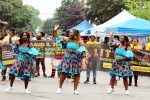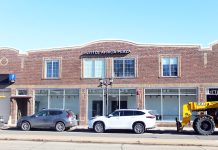
For the ninth year, African immigrants in the Twin Cities recently held the Little Africa Festival and Parade to showcase the continent’s diverse cultures. But this year’s festival was special because, in addition to the usual art, products, food, and performances, it featured the groundbreaking for the construction of Little Africa Plaza on North Snelling Avenue, in the Hamline-Midway neighborhood of St. Paul.
The plaza will have retail space, an African museum, and a new headquarters for African Economic Development Solutions (AEDS), the nonprofit that organizes the festival.
“[This will be a] cultural display project to build a new pan-African culture,” said Dr. Gene Gelgelu, executive director and founder of AEDS said.
The construction of Little Africa Plaza is the latest development in an immigrant community that is increasingly becoming important to the economic and cultural fabric of the state of Minnesota. In the last two decades, the population of Black immigrants living in the state increased by 274% to an estimated 100,000, placing Minnesota among the top 10 destinations, according to the Pew Research Center. In 2018, the Federal Reserve Bank of Minneapolis estimated that African immigrant households had a spending power of $1.8 billion, after paying more than $640 million in federal, state, and local taxes. Economic activities in centers like Little Africa Plaza are often the drivers of growth in communities of immigrants from the continent.
For funding and lending, African immigrant entrepreneurs in the state often rely on community financial institutions like Africa Development Center, and AEDS, whose mission to strengthen the role of Africans immigrants in the economy, culture, and livelihood of the Twin Cities. AEDS offers a list of services like business lending, business development, homeownership education and community building. The Plaza will centralize AEDS’s resources, operating at the heart of Snelling, home to notable African immigrant businesses like Snelling Café.
The Little Africa Festival, which was held at Hamline Park, spotlighted a variety of African businesses, promoting cultural awareness, fashion, personal care, and knowledge-building through Afro-centered books about the African continent.
Prior the commencement of the parade, Corey Boyd, senior public engagement liaison for Gov. Tim Walz spoke about the importance of solidarity.
“When you start bringing everyone together, you’re opening up for everybody, [so] that even those who are not a part of the culture can learn the culture,” Boyd said.
The festival had a main stage where local artists performed spoken word, rap songs and traditional cultural dances. Titambe West African Dance Ensemble got the crowd moving with riveting drum melodies and dance moves. The ensemble got the crowd prepared for the parade down Hamline Avenue, led by AEDS and Little Africa organizers.
Members of the Oromo Youth Association and the University of Minnesota’s Oromo Student Union performed a series of traditional dances from the Oromo region in Ethiopia. There was also a fashion show that exhibited traditional clothes from Nigeria, Kenya, Ghana, and Cameroon. Vendors of Somali, Kenyan, and Jamaican food provided a variety of traditional cuisine from the African diaspora.
Little Africa Plaza will cost an estimated $4.5 million and is scheduled to be completed in the spring of 2024. Gelgelu, the AEDS director, said it was important to show the hard work and resilience of African immigrants.
“We need a collective culture showcased,” said Gelgelu. “To showcase our youth, our future, to learn within Africa, and to showcase that to others outside of Africa.”










